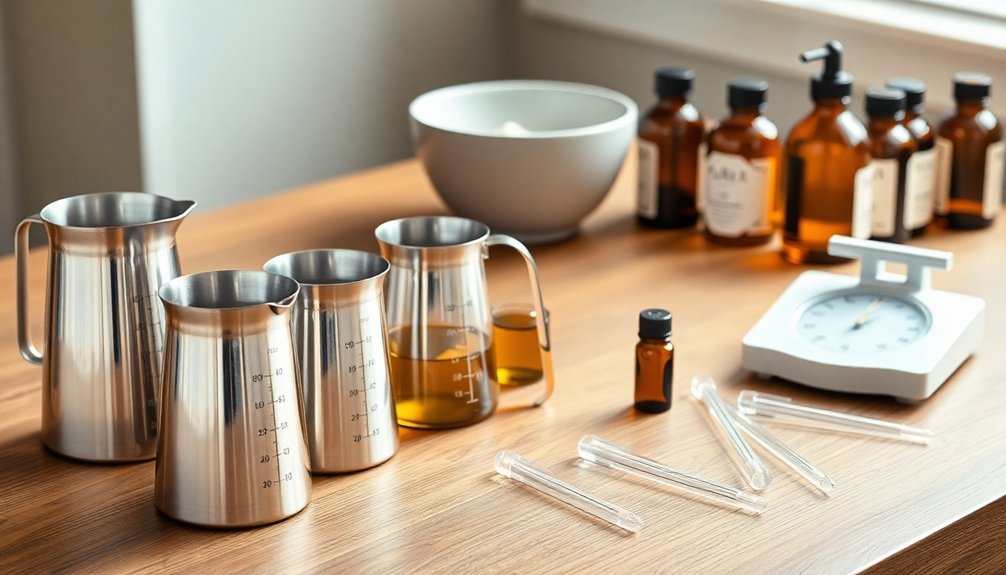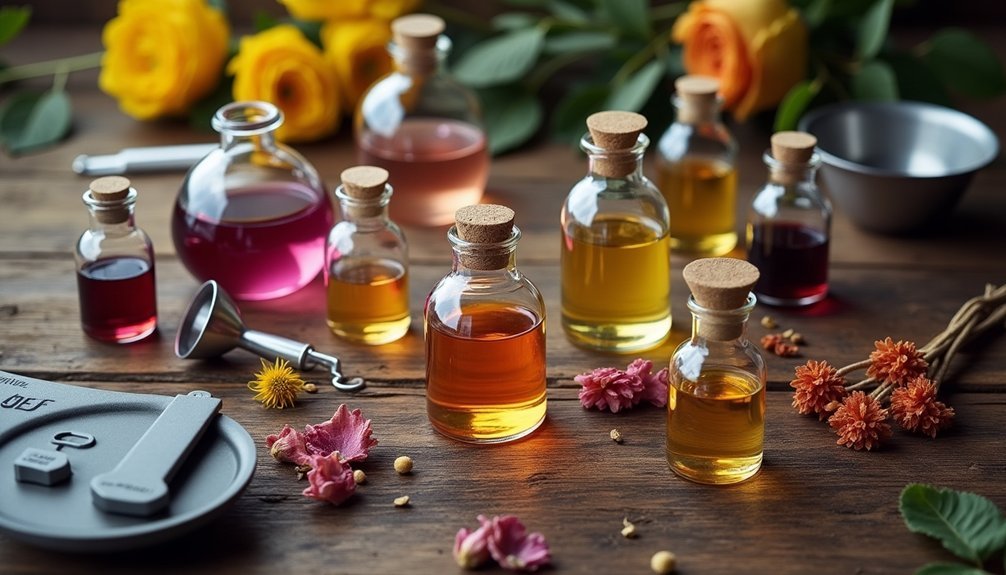To start making perfumes at home, you'll need essential tools like glass beakers, pipettes, and digital scales for precise measurements. Don't forget safety gear including nitrile gloves, goggles, and masks for protection while handling oils. You'll also want amber glass bottles, droppers, and labels for storage and organization. A well-ventilated workspace with fragrance blotters and test strips will help you evaluate your creations. Let's explore the complete setup for your perfume-making journey.
Starting Your Home Perfume Lab: Basic Equipment

Three essential categories of equipment form the foundation of your home perfume lab: basic lab tools, handling implements, and safety gear.
You'll need glass beakers, fragrance blotters, and bottles with caps and droppers for your core setup. Don't forget small adhesive labels to track your creations.
For handling ingredients, you'll want pipettes for transferring liquids, glass stirring rods for mixing, and metal spatulas for working with solids. A magnetic stirrer can make blending more efficient. A reliable digital scale measuring helps ensure precise measurements of your ingredients.
Your safety equipment shouldn't be overlooked. Stock up on protective gloves, safety glasses, and masks.
You'll also need appropriate protective clothing to guard against spills. Keep sterilization materials like ethanol on hand to maintain a clean workspace, and always have a notebook ready to record your formulations.
Measuring Tools for Precise Perfume Blending
Precision stands at the heart of successful perfume making, requiring a specialized set of measuring tools for accurate blending.
You'll need a digital scale that measures to the hundredths (0.00) with a capacity of 100-200 grams for weighing ingredients accurately, as weight measurements are more reliable than volume.
For liquid measurements, invest in a 4-cup glass measuring cup with clear graduations in both fluid ounces and milliliters. Store your mixed formulas in amber glass bottles to maintain their quality and prevent degradation from light exposure.
Add glass measuring cylinders and borosilicate beakers for precise dilutions.
Syringes and disposable pipettes are essential for small-quantity measurements, while metal or glass funnels help transfer your finished formulas.
Don't forget a reliable thermometer for temperature-sensitive ingredients and filter papers to guarantee your fragrances remain pure.
Remember to sterilize all equipment before use.
Essential Storage Solutions for Fragrance Making

Proper storage of your handcrafted perfumes is just as important as precise measuring and blending.
You'll want to keep your creations in cool, dark places away from direct sunlight and heat sources to maintain their quality and prevent degradation. Sealed bottle caps are crucial to protect your perfumes from air exposure and oxidation.
When setting up your perfume-making workspace, consider these essential storage solutions:
- Invest in wooden or velvet-lined storage boxes to protect your bottles from light and temperature fluctuations.
- Set up a dedicated drawer system with custom inserts for different bottle sizes.
- Use mini fridges to maintain consistent temperature for temperature-sensitive ingredients.
- Install floating shelves or wall-mounted acrylic displays for easy access to frequently used items.
For a budget-friendly approach, you can repurpose vintage cabinets, spice racks, or mason jars to create an organized and functional storage system that matches your aesthetic preferences.
Safety Gear Every Home Perfumer Needs
When you're working with fragrance materials, you'll need essential protective gear including a lab coat or apron, safety goggles, and nitrile gloves to shield yourself from potential hazards.
Your safety equipment must be properly fitted and regularly inspected to guarantee it provides reliable protection during your perfume-making activities.
Working in a well-ventilated space with proper respiratory protection and access to emergency equipment like eye wash stations will help you handle concentrated oils and chemicals safely.
Basic Protection Must-Haves
Safety should be your top priority before exploring the art of home perfume making.
You'll need essential protective gear to handle fragrances and chemicals safely in your workspace.
Here's what you must have:
- A lab coat or warehouse coat made of chemical-resistant fabric to protect your clothing, paired with a plastic apron for extra protection against spills.
- Safety goggles or spectacles with anti-fog coating to shield your eyes from splashes, plus access to an eye wash station.
- Nitrile gloves (not household rubber gloves) that you'll need to change frequently and dispose of properly.
- A mask designed specifically for oil vapor protection, used in a well-ventilated space.
Remember to maintain all your safety equipment regularly and replace items as needed to guarantee maximum protection during your perfume-making journey.
Handling Hazardous Materials Safely
Successful home perfume making depends on your commitment to handling hazardous materials with the right protective gear.
You'll need a lab coat or warehouse coat to protect your clothing from essential oils and chemical spills, along with closed-toe shoes and durable clothing that's easy to clean.
For your eyes and face, wear safety goggles to prevent chemical splashes, and use a mask to protect against strong vapors.
Don't forget nitrile gloves – they're essential for handling concentrated oils and chemicals. Select gloves based on the materials you're working with and replace them regularly.
Keep your workspace well-ventilated and organized. Store your chemicals in designated areas, and make sure you have access to an eye wash station and fire extinguisher.
Always inspect your safety gear before starting any perfume-making session.
Testing and Evaluation Equipment

The art of perfume making requires proper testing and evaluation equipment to guarantee your creations meet the highest standards.
You'll need several essential tools to properly assess and adjust your fragrances.
- Start with fragrance blotters and test strips to evaluate scent character and longevity, keeping them organized in scent strip holders.
- Use dark bottles and droppers to store and measure your perfumes while monitoring how they develop over time.
- Invest in digital scales and precision pipettes to make accurate measurements when adjusting your formulas.
- Don't forget safety equipment – you'll need protective gloves, safety glasses, and masks to handle ingredients safely.
Keep a notebook handy to record your observations, and use small adhesive labels to identify your different samples during the testing process.
Mixing and Blending Instruments
Creating enchanting perfumes requires a thorough set of mixing and blending instruments to transform raw materials into refined fragrances. You'll need various vessels and tools to measure, mix, and blend your ingredients with precision.
| Essential Tools | Primary Use | Material Type |
|---|---|---|
| Beakers & Bowls | Measuring & Mixing | Glass & Steel |
| Pipettes & Droppers | Transfer & Adding | Monprene & Glass |
| Funnels & Strips | Pouring & Blending | Steel & Paper |
| Spatulas & Rods | Stirring & Mixing | Metal & Glass |
For accurate measurements, you'll want digital scales and graduated cylinders. Don't forget essential items like glass stirring rods and thermometers for temperature monitoring. Keep your materials organized with labeled containers and record your formulations in a dedicated notebook. These tools will help you maintain consistency and precision in your perfume-making process.
Bottling and Packaging Essentials

Professional bottling and packaging form the cornerstone of preserving your handcrafted fragrances while establishing your brand identity.
You'll need high-quality glass bottles as your primary containers since they're nonreactive and protect your scents from degradation. For travel sizes and samples, consider using durable PET or HDPE plastic bottles.
Essential bottling and packaging supplies include:
- UV-protective colored glass bottles in various sizes for your main product line
- Reliable spray nozzles and tight-fitting caps to prevent leakage and evaporation
- Clear, informative labels that display your brand elements and fragrance details
- Secondary packaging materials like decorative boxes with custom finishes
Remember to test the compatibility of your fragrances with the closures and guarantee all packaging meets safety standards for handling and transport.
Tools for Small-Batch Production
After securing your bottling supplies, you'll need an extensive set of tools to bring your fragrance creations to life. Focus on acquiring precision instruments that'll help you measure, mix, and evaluate your perfumes accurately.
| Essential Tool | Primary Use |
|---|---|
| Analytical Balance | Precise ingredient measurements |
| Glass Beakers | Mixing and blending fragrances |
| Glass Pipettes | Transferring small amounts |
| Filter Papers | Removing particles and sediments |
| Scent Strips | Testing fragrance combinations |
You'll want to start with borosilicate glass beakers in various sizes and high-quality glass pipettes for handling delicate ingredients. Don't forget a reliable analytical balance that measures to 0.001g precision for your formulations. For testing, keep plenty of scent strips on hand, and guarantee you've got proper filtration tools to achieve crystal-clear results.
Frequently Asked Questions
How Long Does Perfume Making Equipment Typically Last Before Needing Replacement?
You'll find most equipment lasts several years with proper care. Your glass beakers can last indefinitely, scales need yearly calibration, and pipettes require occasional replacement. Filters need more frequent changes after each use.
Can I Use Kitchen Utensils Instead of Specialized Perfume Making Tools?
You shouldn't use kitchen utensils for perfume making. They lack precision, aren't chemically resistant, and pose safety risks. Instead, invest in proper equipment like digital scales, glass beakers, and protective gear.
What's the Minimum Budget Needed for Basic Perfume Making Tools?
You'll need at least $50-75 to start with basic perfume making tools. This covers a digital scale ($20-30), glass beakers ($15), pipettes ($5), and essential storage bottles ($10-25) for your initial setup.
Where's the Best Place to Store Perfume Making Equipment at Home?
You'll want to store your perfume equipment in a well-ventilated, separate space like a garage or dedicated room, using plastic storage boxes and tiered racks. Keep everything away from living areas to control odors.
Should Perfume Making Tools Be Sterilized Between Different Fragrance Batches?
Yes, you'll need to sterilize your tools between fragrance batches to prevent cross-contamination. Use ethanol or UV sterilization to maintain scent purity and avoid mixing different fragrances in your new creations.
In Summary
You'll find that starting your home perfume-making journey doesn't require an overwhelming investment in tools. With your basic measuring equipment, storage containers, safety gear, and blending instruments in place, you're ready to begin creating unique fragrances. Remember to prioritize quality when selecting your tools, as precision and proper storage are essential for successful perfume making. Start small, and expand your collection as your skills grow.





Leave a Reply